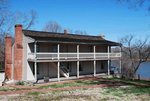

Dyers Creek. I drive past it quite often near our place in Tennessee. We have went kayaking up and down it numerous times. It is very quiet in the evenings and we enjoy the cranes that hunt for fish at the water’s edge and the deer that come to the bank to get a drink as we slip silently by. Fish break the surface of the water around the kayak. I always thought it would be interesting to have one hop in the kayak. Much more manageable than a water snake.
We use the boat launch there to put the boat into the Cumberland River. The river is shallow and narrow and one must be careful not to run the prop into the mud right where it meets the mighty Cumberland. Like every place in Tennessee it has over two centuries of history to tell if you look and listen.
Stewart County was first settled by pioneers from North Carolina, who arrived around 1795. The military granted up to 1,500 acres to survivors if the Continental War from 1795 to 1805 and many took advantage of the offer. A party of surveyors arrived first to run the lines of land tracts. One night while the eight men were camped along what is now Dyers Creek, they were attacked by Indians and four of the group were killed. One of the surveyors, Thomas French, escaped the ambush but did return later to claim property. The settlers built two story log house-forts to help protect from the Indian attacks since most of the indigenous people there were very hostile. Up until 1812 the militia made patrols up and down the Tennessee River to protect the settlers from Indian raids.
Some of the locals relate that the name was a result of the surveyors being left to die after the Indian attack. I soon learned that spelling and pronunciation is not a strong point with long-time Tennessee residents. Dyers Creek was named after Robert Henry Dyer who was a cavalry colonel in the War of 1812 and the 1818 Seminole War. He settled in the area and later became a Tennessee state senator.
Wildlife was available to feed the early settlers in the Tennessee woodlands and game of every description could be found in abundance. Judge James Scarborough lived along Dyers Creek and related a story that happened about 1807. The Judge and his sons left the farm to attend court while his wife, Mary remained at home to tend the livestock. The county seat was some distance and it was necessary to remain overnight. During the evening a large black bear was detected prowling around the place and got in amongst the pigs. The dogs were set on it and the bear climbed a tree by the house. By this time it was dark and Mrs. Scarborough could not distinguish the form of the bruin in the tree so she built a large fire under the tree and waited through the night in vigil. When the morning came, she took her husbands rifle and killed the bear and proceeded to skin it.
In the early days of the settlements there were very few stores in the area. Many supplies came from New Orleans and were brought up the river in Keel Boats powered by hand. They would bring dry goods up the rivers and exchange for furs, skins and other produce. It took a full six months to make a round trip.
In 1804 Mason Bennett opened a general merchandise store at his house and also sold whisky. Most of the early 1800 accounts of merchants were of men who opened a tavern at their house. Due to the extremely hilly terrain and plentiful rivers in Tennessee, most travel was by water and most settlements were along the river. As more settlers arrived and started businesses, many small towns sprang up throughout the state. The Dover Hotel was built on the banks of the Cumberland River in the mid 1850’s and is still standing, thanks mostly because it was the location of the signing of the surrender between the Union General Grant and Confederate General Buckner after the Battle of Fort Donelson. It served as the General’s headquarters and a hospital during the battle. After the war it continued as a hotel until the 1930’s.